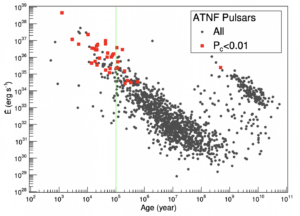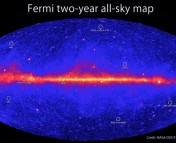Title: The First LHAASO Catalog of Gamma-Ray Sources
Authors: The LHAASO Collaboration
First Author’s Institution: Key Laboratory of Particle Astrophyics & Experimental Physics Division & Computing Center, Institute of High Energy Physics, Chinese Academy of Sciences, 100049 Beijing, China

Status: Available on ArXiv
A huge LHAASO for catching huge[ly energetic] gamma-rays
The high energy astrophysics community has been abuzz since the Large High Altitude Air Shower Observatory (LHAASO) released its first catalog of ultra high energy (UHE) gamma-ray sources. LHAASO is a particularly cool instrument because it surveys the whole northern sky every day for the most energetic gamma-ray photons ever detected.
It’s a massive combination of different detectors (see figure 1) that work together to image the sky from 1 TeV up to ~1 PeV (see figure 2 for a guide to high energy wavelengths). Since the atmosphere blocks out most of these dangerously high energy particles, LHAASO uses a variety of different detectors to look at radiation from lower energy secondary particles that come from the original gamma-ray interacting with the atmosphere.
Do the cosmic rays follow the gamma-rays?

So why are these UHE photons so important? It’s because all photons are uncharged and travel directly to Earth along straight paths, pointing right back to the sources that made them. In particular, the sources of UHE photons are the most energetic sources in the universe like supernova remnants, active galactic nuclei (AGN), pulsars, and more!
Also, we know that cosmic rays (generally charged particles, like protons) are bombarding the Earth at energies beyond a PeV (see figure 3), but don’t know where they’re coming from! When charged particles journey from their birthplace to Earth, magnetic fields in the Milky Way shoot them off into all sorts of different directions. This is where gamma-ray photons come to the rescue! If we see photons at similar energies to cosmic rays coming from a certain astrophysical object, we can study things like the morphology and energy distribution of the photons to see if these match up with the models we have for the types of environments that could produce cosmic rays.

Because these sources can make particles up to PeV energies, we’ve given them a fun name – PeVatrons! PeVatrons are worthy of the excitement because they produce particles at much higher energies than anything we can make in labs on Earth (e.g., the LHC, which can get up to ~13 TeV), making them excellent labs to test fundamental physics and look for new physics we aren’t yet aware of!
So what’s in the catalog?!
Since turning on in 2019, LHAASO has given us a few teasers about what lies in the UHE sky, like the unidentified source from this bite, the brightest (gamma-ray burst) of all time (BOAT) GRB221009A from this bite, and the crazy energetic Crab nebula detection. Today’s authors announce a plethora of new LHAASO sources with the very first LHAASO catalog: 1LHAASO.

Here’s the breakdown of today’s catalog: there’s 90 total sources (see figure 4) that have been detected, with 32 brand new sources that have never been seen by other instruments, and 43 with energies above 100 TeV. Arguably the most interesting sources in this catalog are a new class of gamma-ray sources – previously unknown objects detected only in LHAASO’s higher energy detector called KM2A and sensitive to energies > 25 TeV (see figure 4 for an example). This is unexpected because usually only photons at lower energies than these make it to Earth due to absorption processes near the source or scattering off of the cosmic microwave background on the way (which affects extragalactic sources and is also why figure 4 shows many more sources along the Galactic plane). For these reasons, we usually see more photons below ~30 TeV and way fewer at higher energies – so why is LHAASO seeing the opposite? We don’t really know yet, but it’s definitely something exciting and new.

Can I order a dark & PeVatron?
The authors note that some of these UHE-only sources are also so-called “dark sources” that have no counterparts at lower energies. It’s really unclear what could be powering these, especially since survey instruments like LHAASO don’t have great spatial resolution, making things look pretty blobby and hard to characterize. These sources could also be PeVatrons, so it’s clear that they’re worth looking into a little deeper. Instruments that are capable of better angular resolution can to try and map out the more intricate structure of some of these sources. Some great tools for this are ground-based VHE telescopes, called IACTs, like VERITAS, H.E.S.S., MAGIC, and the upcoming CTA.
Are any of these sources any less mysterious?
It turns out some of the UHE sources are located near known gamma-ray sources! For example, there are 35 LHAASO sources associated with pulsars. This is pretty important, because the energetic nebulae surrounding pulsars, called pulsar wind nebulae (PWNe; e.g., the Crab nebula), have long been thought to be sources of PeVatrons; we just haven’t had the instruments to detect up to PeV energies until LHAASO.

Most of these pulsars are young and energetic, which makes them capable of being pretty good particle accelerators, but it still remains unclear why we’re only seeing the highest energy emission from these sources. This kind of coincides with another new source class seen a few years ago by the HAWC observatory (which is a similar idea to LHAASO’s WCDA) called TeV halos. TeV halos are different from PWNe in that they are also found around older pulsars, at which point the PWN is unobservable as it has aged and expanded, and is not producing super high energy particles anymore. TeV halos are also only detected at TeV energies (and maybe higher energies, as suggested by today’s paper), as opposed to PWNe that are seen in radio, X-ray, and all gamma-ray energies. Right now, the leading theory for TeV halos is that they’re formed by escaped particles from the PWN either interacting with the supernova remnant (for young pulsars) or the interstellar medium surrounding the pulsar (for middle-aged and older pulsars).
Looking through the LHAASO and into the future
There’s also a lot of implications for existing sources detected at much higher energies than we previously thought they could reach , such as the Crab nebula, AGN, gamma-ray binaries, and more! So whether you’re interested in learning more about the sources illuminating gamma-ray sky we already know, or figuring out what’s powering the new sources that only LHAASO sees, there’s lots to learn from the 1LHAASO catalog. It’s an exciting time to be studying the high energy universe, and hopefully we’ll learn a lot more by pointing all sorts of different telescopes at these sources!
Astrobite edited by Isabella Trierweiler
Featured image credit: NASA




